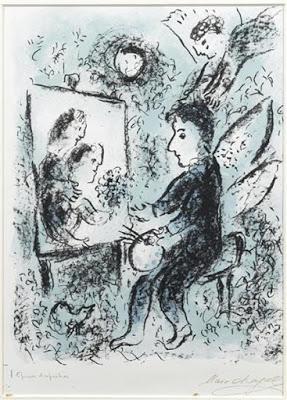
Clarity to Each Other by Marc Chagall*
I recently got an email from a reader that piqued my interest because it was about something I’ve been thinking about lately: how to practice yoga what there is something significant you can no longer do, either temporarily or permanently. Here’s the initial message: “Nina, good morning. We seem to be on a floor theme lately which is of particular interest because I have a foot injury (pulled tendons from metatarsals to two toes) which my foot doctor says will take 8-10 weeks to heal and is quite painful. I’m looking for an active (as in somewhat challenging) sequence that does not involve any standing work. Can you or Baxter suggest something? Or point me to an existing sequence?” —TerriI thought to myself, okay, so here’s someone who can’t practice any standing poses or, I assume, poses that bear significant weight on the feet. And since we didn’t have a sequence for someone in that condition on the blog (we may soon—so stay tuned), there were two possible ways I could respond to this: 1. Create a sequence for Terri myself. 2. Teach Terri how to take care of this situation herself. Naturally I went for the second option! Obviously the second option would be more empowering for Terri, as she would get to participate in solving her own problem and it would also set her up for similar types of situations in the future. But also I knew exactly what to say because I’ve been through this myself (practicing with a frozen shoulder is just one example). So here’s what I wrote back to Terri: “What I would do in your place is to sit down with a yoga book and find all the active poses that you can do without standing on your feet and try to make create sequences out of that. There are lots of backbends, twists, and forward bends that you could do. Of course, reclined stretches will also work. And Gate Latch pose (Parighasana) would be good alternative to the standing poses.” —Nina Terri replied that she really liked this idea, which she hadn’t thought of. What she had been doing so far, she said, was just practicing poses “as they pop into my head.” But she now realized that being more “systematic” about it might be a better way to go. Still she felt a bit unsure about her sequencing abilities so she wondered if I would check her work and make some recommendations. While I normally can’t spend time working with individuals on customizing their yoga practices (unless they are my private students), I decided to do so this time because I thought I’d learn something, which turned out to be the case. A few days later Terri sent me two “no feet” sequences. She had a good collection of poses in her sequences (even though I could think of even more, on her own she’d come up with more then enough keep a person busy). But—without going into details about it—I could see right away that even though she practiced Iyengar-style yoga she wasn’t really familiar with basic Iyengar-style sequencing (see Iyengar-Style Sequencing, Part 1). So I did make a few recommendations for changing the order of her poses and I explained why I had made those changes. (I’d like to make it clear that this wasn’t because I thought her way of sequencing was dangerous, but I just thought the practice could be a better physical and emotional experience if she moved the shoulder openers before the backbends, the backbends before the forward bends, and so on.)After reading through my comments, Terri replied enthusiastically, "Not surprisingly to me, your sequences are much more logical than mine!" And I, myself, came away from this experience with a feeling of clarity about some basic rules for what anyone should do if there is something significant they can no longer do, either temporarily or permanently:1. Do some research, and make a list of all the poses you can do in your current condition. 2. Create two or more sequences from these poses—so you don't have to do the same thing every day—in the style of yoga that you typically do. These can either be balanced sequences, containing a mixture of pose types, or they can be more focused practices, such as a backbend practice, a forward bend practice, or a twist practice.3. If you don’t know how to sequence, see if you can find some basic information about this or ask your teacher for help. The following posts have information about sequencing. So far, we only have information about two yoga styles: Sequencing: An Essential Skill for Home Practice by Baxter
Sequencing in the Style of Krishnamacharya, Part 1 by Baxter
Sequencing in the Style of Krishnamacharya, Part 2 by BaxterIyengar-Style Sequencing, Part 1 by NinaIyengar-Style Sequencing, Part 2: Warming Up by NinaThese posts about warming up could also be helpful:Classic Static Warm Up Poses by NinaDynamic Floor Warm Up by BaxterSeated Warm Up by BaxterStanding Warm Up by BaxterKneeling Warm Up by Baxter Subscribe to Yoga for Healthy Aging by Email ° Follow Yoga for Healthy Aging on Facebook and Twitter ° To order Yoga for Healthy Aging: A Guide to Lifelong Well-Being, go to Amazon, Shambhala, Indie Boundor your local bookstore.
For information about Nina's upcoming workshops and retreats and other activities, see Nina's Workshops, Retreats, and Books.

